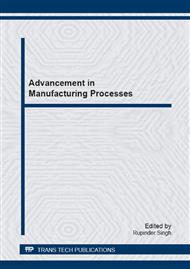p.1
p.11
p.19
p.35
p.43
p.51
p.65
p.79
Parametric Investigations into Bore Honing through Response Surface Methodology
Abstract:
In the existing literature, the effect of various process parameters of Bore Honing on some of the quality characteristic has been reported, but the information as to how these parameters interact with each other during the operation is inadequate. Therefore, it is required to study the combined effect of the input process parameters on the performance of honing operation in order to develop parametric relationships. In the present paper, parametric relationships have been developed between three input process parameters namely, Reciprocating Speed, Over-run, and Rotational speed and three response parameters i.e. Taper, Out of Roundness, and Surface finish by the application of Response surface methodology (RSM). Strong interaction was observed between various input parameter while affecting the performance of the process. The study of response surfaces revealed some interesting facts about Bore Honing Process.
Info:
Periodical:
Pages:
11-18
Citation:
Online since:
December 2014
Authors:
Keywords:
Price:
Сopyright:
© 2015 Trans Tech Publications Ltd. All Rights Reserved
Share:
Citation:


